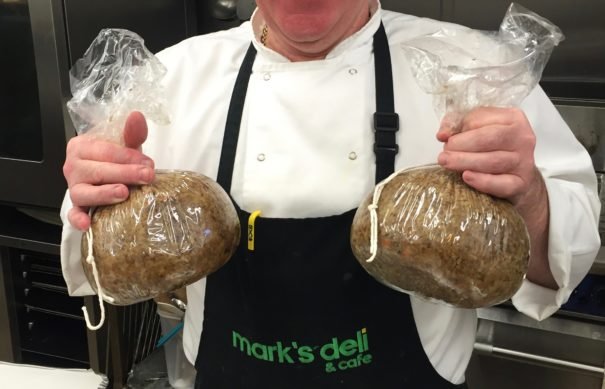
Sorry: Keeping Kosher is No Longer an Excuse Not to Eat Haggis

Sorry: Keeping Kosher is No Longer an Excuse Not to Eat Haggis
Haggis in Glasgow
The scene is about what you’d expect from any Jewish deli on a weekday afternoon: chopped liver, cream soda, old people talking loudly at each other over bowls of chicken soup. Which makes it all the more surreal when Mark Cohen gestures at a thimbleful of liquid on the table between us, then points at my plate. “That’s whiskey that you just pour over it,” he says. “To give it real Scottish flavor.”
This is Mark’s Deli, Scotland’s only kosher deli, which Cohen opened in 2007. On my plate is haggis—or at least, a special version of it.
In its original form, haggis is a rich hash of sheep’s innards, suet, oatmeal, onions, and spices, traditionally cooked in a sheep’s stomach. It’s been a potent culinary symbol of Scotland for centuries. Scots concede that it’s an acquired taste, but it’s ubiquitous at special occasions nationwide, and also at not-so-special occasions: many chip shops catering to late-night drinkers offer haggis pizza or haggis spring rolls.
Because the sheep parts in commercial haggis aren’t butchered according to Jewish dietary laws, the specialty was long out of reach for Glasgow’s small Jewish community. But today, I am sampling Cohen’s interpretation of haggis, which uses minced, kosher lamb, but none of the heart, lungs, liver, and stomach from the more traditional recipes.
Cohen’s family has been cooking for Glasgow’s residents since the 1930s, when his great-great-aunt ran a restaurant that fed, among others, Polish soldiers with nowhere else to go. His mother, Doreen, made her first kosher haggis for her catering clients in 1987. And although the city’s Jewish population is slowly shrinking, Cohen still turns out over 220 pounds of his haggis annually.
Most of this haggis production is for Burns Night, Scotland’s annual celebration of its national poet, Robert Burns, who wrote Auld Lang Syne. On or around January 25 at Burns Suppers nationwide, a host or a guest of honor will recite Burns’ Address to a Haggis to tables full of hungry people before ceremonially slicing open the haggis with a sword (or kitchen knife.) A grand meal follows, with the haggis usually accompanied by turnips, potatoes, (“neeps and tatties”) and whisky sauce.
The Burns Supper at Cohen’s synagogue always sells out because they can only seat 200. Cohen serves me his haggis the way he serves it at Burns Night: in a neat cylindrical shape under layers of neeps and tatties. The vegetables are a formality; the haggis is the star. It’s loose and lean as a pilaf, and has a toothsome, malty chew from the barley Cohen adds. A heady lamb perfume permeates every crumb, and while there’s none of the fat, silken mustiness of offal, in its place are the warmth of browned onions and black pepper. I eat it all.
At his synagogue’s celebration last year, Cohen had the honor of addressing the haggis. He recites the poem for me from memory and with gleeful drama.
Robert Burns is for all Scots, says Cohen, and a good delicatessen should be the same. “In New York City, deli food is just part of the culture—we’d like to develop that same ethos in Glasgow.”